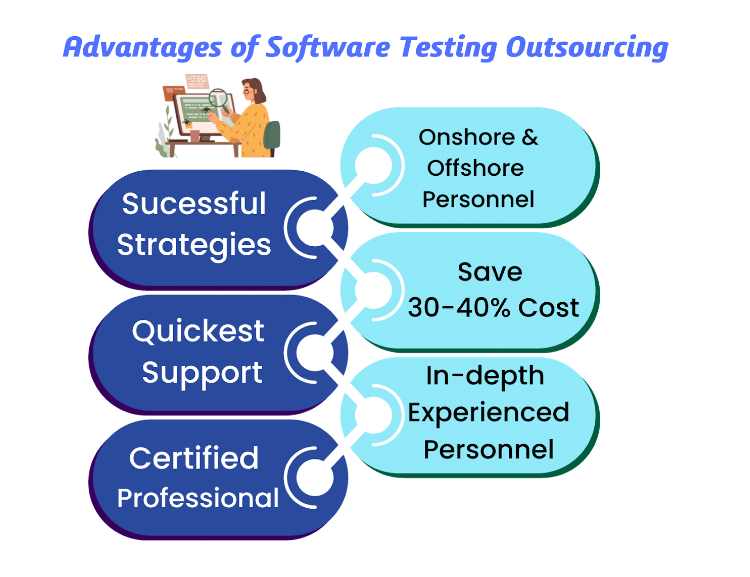
Unraveling Challenges of Software Testing: Overcoming Obstacles and Finding Solutions
With the advent of technological advancement, challenges also reign over the industry. In the technical industry, all web apps and mobile apps should be fortified as per the latest trends in software development and user expectations. The emergence of agile methodologies in software testing outsourcing companies has made it quite easy for software teams to upgrade the software for real users.
The software testers face many hurdles in the quality assurance process in staying tuned with the fast practices and accurate testing. So, this blog post highlights the unraveling challenges of software testing and its solutions in the cut-throat competitive market.
Let us start:
4 Key Challenges in Software Testing, Their Solutions
Have a look at the given hurdles that often come in the seamless path of software testing outsourcing:
-
Communication Barriers
Lack of communication while delivering the software requirements can create obstacles in building absolute test cases. This communication gap can happen due to the time zone differences between clients and developers and different shifts. One must make a note of it that QA outsourcing can be conducted if the business and technical requirements are clear by the product manager’s side.
Solution:
Discussions between the software development and software testing teams must be carried forward at regular intervals, keeping the product managers in the loop. This will ensure transparency that every step in the testing process is going in the right direction. Clear objectives enable the testers to develop and execute user-friendly test cases. Moreover, the delivery time of the product will also be improved.
-
Unsteady Environment
The process of software product release often has a negative impact in an unsteady environment. Due to the poor management and disputes in the team, the effectiveness and caliber of the test setting were affected a lot.
Also Read: 5 Ways To Improve Your Software Testing Process
Solution:
The software testers should make a habit of formalizing the test environment requirements prior to the life cycle of testing. This will eliminate the challenges that come with the unsteady environments.
-
Inadequate Testing
To detect the product difficulties, one must encounter the real-world setting. Focusing on a small number of test cases will not work accurately. The gaps in the realistic test environment will reduce the possibility of flaws, errors, loopholes and bugs deeply. In that case, the tester will be able to find the flaws under very particular scenarios.
Solution:
It is crucial to test the software product using the real-world setting. To solve the above problem, the software testers must test the product in all feasible configurations considering the end-user interaction with the product. Once the flaw gets caught, the tester must resolve it ASAP.
-
Insufficient scrutiny of Prerequisites
While working on some projects, the software testing team sometimes lost the documentation (scope) provided by the side clients at the time of verbal discussions. Hence, this becomes the reason for missing out on the expectations of the client. On account of this, the testers proceed with the general assumptions, causing delays in conducting unnecessary and cross-functional tests, resulting in unwanted features in the application.
Solution
Making a comprehensive and specialized document for the client’s requirements is a must to avoid the above challenge. The complete documentation process will be the backbone for the QA engineers in the entire project lifecycle. As a result, the QA support team will make an expected product and develop suitable tests.
Also Read: Software Testing Outsourcing: A Cost-Saving Solution
Advantages of TFT in your Software Testing
Conducting the upgradation at regular intervals and on-time release, the business has to opt for the best software testing company. Here comes TFT to provide you with all the benefits of software testing outsourcing. Have a look at the perks in the given creative:

Conclusion
Overall, to address the challenges in the market, software development companies need a strong software testing strategy that can provide them with high-quality assurance.
TFT is one of the best remote software testing companies offering QA support services that will be context-driven, robust and cost-effective. It can triumph over all the challenges to make bug-free software. Here, reliability, availability, performance, and maintainability of the products would be given at a very low price.
So, stay tuned for the upcoming blog edition to learn more about software testing outsourcing. Additionally, email the details of your project at [email protected]
FAQs
1. What are common challenges in software testing?
The most common challenges in software testing are tight deadlines, limited resources, complex test environments, and ensuring comprehensive test coverage.
2. How can I overcome resource constraints in software testing?
To overcome resource constraints, consider test automation, outsourcing, or prioritizing critical test cases to make efficient use of available resources.
3. What are some strategies for improving test coverage?
Strategies for improving test coverage include requirement traceability, risk-based testing, exploratory testing, and using code coverage tools.
4. How do you manage testing in agile development?
Agile testing involves continuous testing throughout the development cycle, close collaboration with developers, and adapting test plans to changing requirements.
5. What role does test automation play in overcoming testing challenges?
Test automation can accelerate testing, increase coverage, and reduce manual effort, helping teams overcome testing challenges efficiently.
Recent Blogs
- RPA Software Solution: Transforming Business with Smarter Automation Tools
- Salesforce Implementation Services: Meet Your New AI Teammates
- Salesforce Services: How Modern Engineering Is Revolutionizing CRM Solutions
- Salesforce Implementation Services: AI-First Integration with Agentforce for Smarter API Documentation & Governance
- 5 Benefits for App Success: Hire Remote React Native Developers
Categories
- Agritech (1)
- AR/VR (5)
- Artificial Intelligence (55)
- Machine Learning (1)
- Blockchain (4)
- Business Intelligence (3)
- CRM (5)
- SalesForce (4)
- Data Engineering (8)
- Data protection (2)
- Development (102)
- Golang Development (15)
- Python Web Development (9)
- React JS (5)
- React native (10)
- Devops (3)
- Hire Developers (3)
- Internet of Things (IoT) (5)
- Kubernetes (2)
- Machine Learning (2)
- Mobile App Development (44)
- Node.js (7)
- outsourcing (7)
- Partnership (4)
- Performance Testing (3)
- RPA (21)
- Security (24)
- Strategy (1)
- Testing (110)
- Accessibility Testing (2)
- Automation Testing (22)
- Dynamic Testing (1)
- Manual Testing (3)
- Mobile App Testing (13)
- Offshore Software Testing (6)
- Penetration Testing Services (13)
- QA testing (16)
- Remote Software Testing (7)
- Software Testing (19)
- Website Design (22)